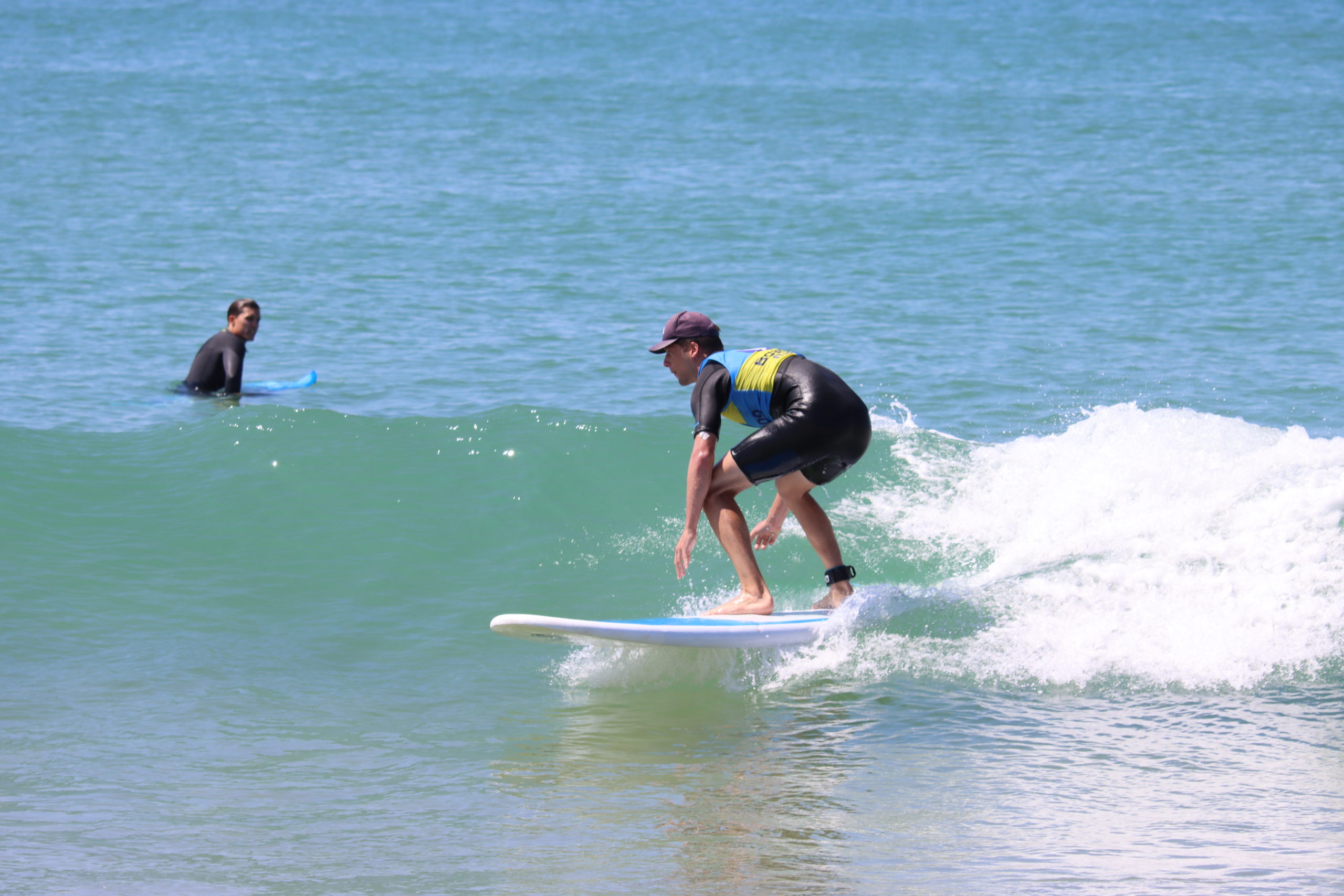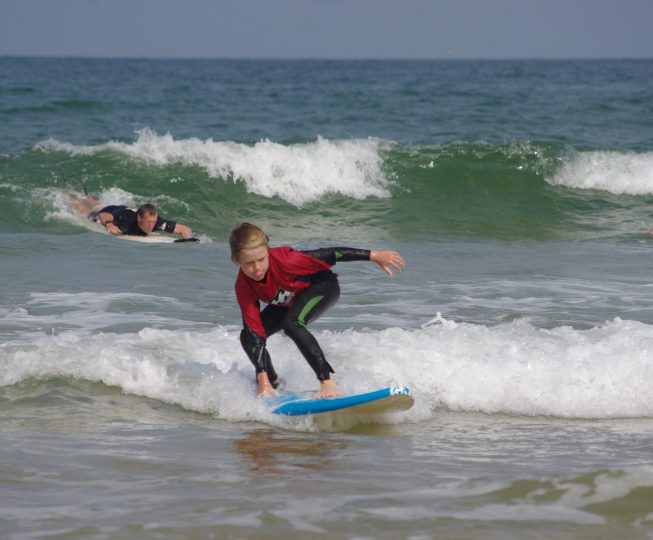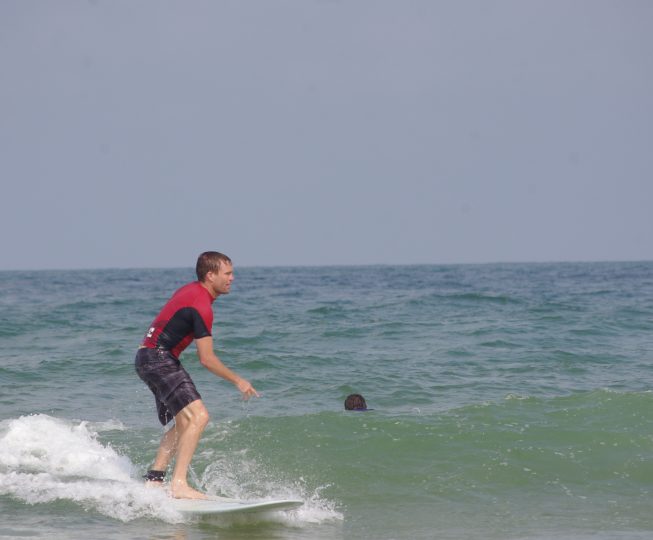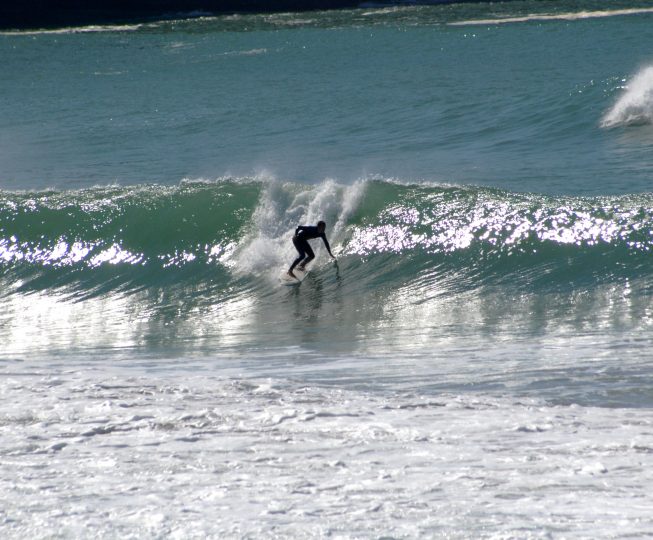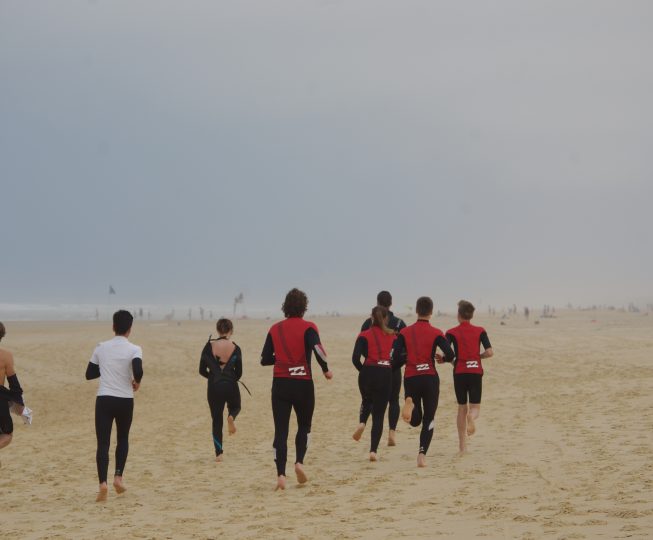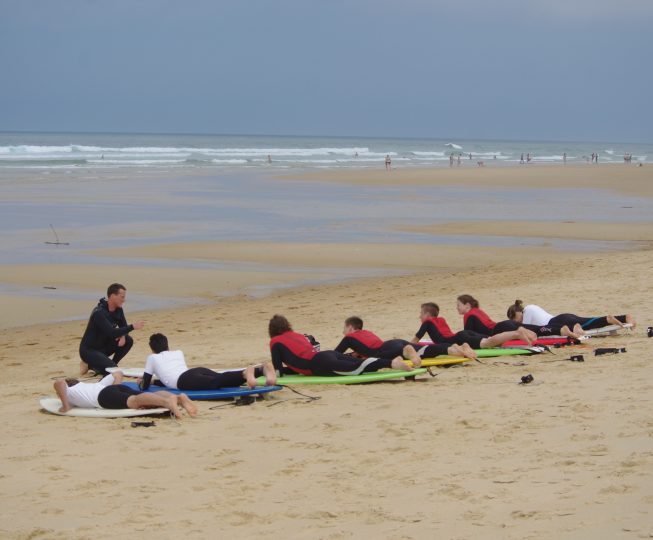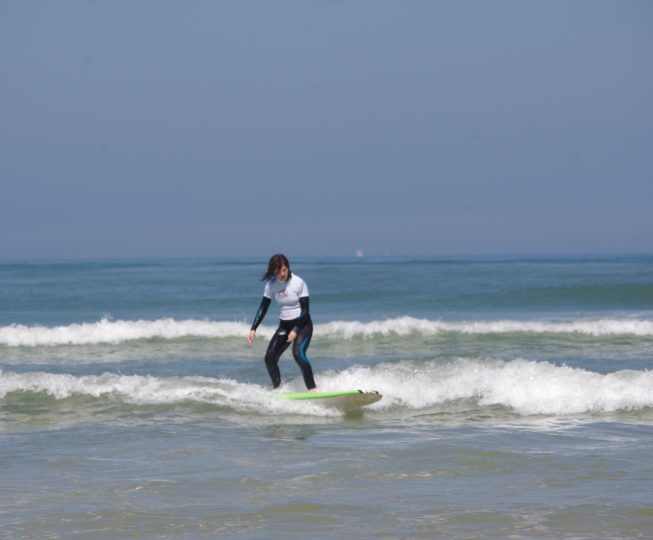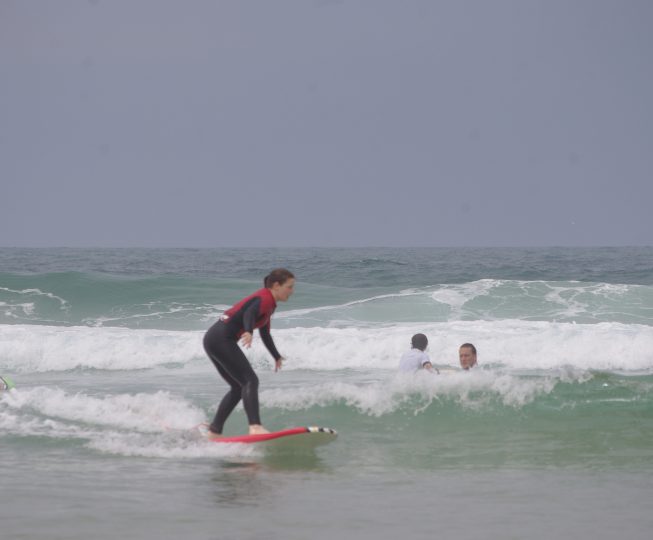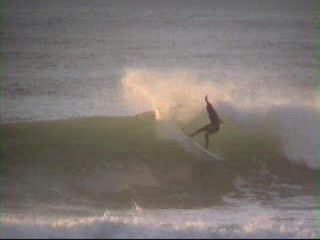The surf school industry standard.
5 days is the ideal. It allows us over a 7 day period to make optimal use of any given conditions. More specifically it allows you to gain a huge amount of knowledge and skill that will set you in good steed for the rest of your surfing career.
The three skill levels
Beginner: surfing in the white water, turning left and right in the foam.
Intermediate: out back, sitting on the board, starting to take small green (unbroken) waves, conditions permitting. Turning left and right on small unbroken waves.
Advanced: turning confidently both left and right on the open face of a wave, keeping in speed, front side and backside with the curl or pocket. Introduction to first manoeuvres, top turn, bottom turn, cut back, duck dive.
Beginner Surf Lessons
Allows the novice surfer to get a real feeling for surfing in a safe environment and with the correctly adapted material. The lesson lasts 2hrs. Maximum 8 surfers per group.
The adult surf lesson encourages you to increase your awareness of the sheer force inherent in nature. You will appreciate the pure size and power of the ocean first hand. You will also learn how to appropriate these forces whilst discovering your own limitations but essentially you will learn how to enjoy yourselves in the process. As a surfer, you will also learn self control and respect. You will learn how to confront, accept and deal appropriately with challenges, but also, how to deal with frustration. Mix all of these in with a certain natural level of apprehension and we have the perfect mix for a solid rise in performance and self esteem, resulting in an increased confidence in your own capacities.
Themes : Discovering and adapting to a new environment. Discovering ones own limits. Self confidence. Learning to listen to ones instincts and gain a certain level of skill in reading and understanding an important element in nature, which in this case, is water.
Price and description of the product
- 170 € per person
- group size: 8 max
- Lesson duration : 2hrs
- Lesson contents: theoretical and practical.
- Choice of equipment: wetsuit with a surf board or bodyboard
An example of a standard beginner surf lesson.
- You will learn how to carry your board by yourself in a safe and controlled manor. You will also learn the easier tandem board carry, allowing you to walk across the beach with your equipment safely and easily.
- Introduction to the elements: the waves, the currents, the sand banks and deep water troughs. And most importantly the rules of safety.
- Introduction to the equipment.
- Warm up and stretch on the beach.
- Warm up in the water: explanation, demonstration and practice in the art of body-surfing (allows both the coach and the young surfers to get a feel for the power of the waves and the currents before the surf session commences)
- Finding your balance on the surfboard in a lying position: on the beach then in the water. The aim is to catch a white water wave or broken wave whilst lying on the surf board. This will allow you to become accustomed to the handling of the equipment in the ocean, the correct positioning and the general process of catching a wave before taking it any further. When you nose dive and you will nose dive you are understanding the importance of weight distribution on the board and it’s effects.
- Now back on the beach we learn how to pop up on the board. This is where the real challenge begins..
- The aim of the lesson is be able to stand on a surf board whilst riding the white water towards the beach. The key to success is to put you feet in the right place on the board in order to keep your balance.
- Debriefing
Choice of equipment
Having the right equipment is a big part of success. The surf board must be suited to your height and weight and to your ability. We provide wetsuits that are specifically suited for men, women and children, and that are adapted to the season. Spring suits (3/2), summer suits (2/2) and winter suits (4/3).
Winter Surf Accessories: hood, gloves and booties.
Access to the changing booths (heated in the winter) and a place to store your personal affairs in safety.
Surf Lessons for Intermediates
Allows the novice surfer to get a real feeling for surfing in a safe environment and with the correctly adapted material. The lesson lasts 2hrs. Maximum 8 surfers per group.
The intermediate surf lesson encourages you to increase your fitness levels and maintain a healthier lifestyle. As a surfer, you will also learn self control and respect, how to confront, accept and deal appropriately with challenges, but also, how to deal with frustration. Mix all of these in with a certain natural level of apprehension and we have the perfect mix for a solid rise in performance and self esteem, resulting in an increased confidence in your own capacities.
Themes : Discovering and adapting to a new environment, in this case we’ll be out back behind the breaking waves in the line-up. Discovering ones own limits. Self confidence. Learning to listen to ones instincts and increase your level of skill in reading and understanding an important element in nature, waves.
Price and description of the product
- 165 € per person
- group size: 8 max
- Lesson duration : 2hrs
- Lesson contents: theoretical and practical.
- Choice of equipment: wetsuit with a surf board or body board
An example of a standard intermediate surf lesson:
- Introduction to the elements: the waves, the currents, the sand banks and deep water troughs. And most importantly the rules of safety.
- Warm up (40m run) and stretch on the beach.
- Learn to pin point your entrance to maximise your chances of an easy approach. Line up positioning once out back. How to use the sand banks and deep water troughs and their respective currents to help you. Understand the different techniques (Eskimo roll – duck diving etc..) that are available to the surfer to make it through the white water and out back when in a paddling position, that is lying in a flat position on the board. Explanation, demonstration and practice on the beach before practising in the water.
- Learn to surf the wave in the curl or the pocket. Learn to read the waves, lefts and rights. Learn how to adapt to lefts and rights by choosing the correct direction to take on the wave. Positioning, where to take the wave, and the timing, when to take the wave are crucial steps to a successful take off and ride. Explanation, demonstration and practice on the beach, then into the water to train. Our aim is to get you riding on the green wave (unbroken part), in order to gain and maintain enough speed to outrun the foam. This will allow you to become familiar with what we call the open face of the wave that evolves further along the wave into the shoulder. This view and position will open up a whole new area and an array of possibilities from which you can start performing manoeuvres..
- Introduction to two paddling techniques: positioning paddling and take off paddling.
- Introduction to basic turning techniques: starting with the direction assisted take off (turning the board in the correct direction that corresponds to the wave before the take off), and then onto the bottom turn (going straight down the face of the wave and performing a high speed turn at the bottom of the wave). You learn the importance of weight distribution and it’s affect on the board and on your speed.
- Introduction to kicking out of the wave.
- The objective of the lesson (conditions permitting) is to try to stand up on the board before the wave breaks and turn either left or right (depending on the wave) in order to surf on the open face of the wave. The key is selecting the right wave that will allow you to do this, then getting in the right position and giving it 110% in the paddling to get onto that wave.
- Debriefing.
If the ideal conditions are not available for example the waves are too big then these techniques can be performed on wave reforms closer to the beach.
Choice of equipment
Having the right equipment is a big part of success. The surf board must be suited to your height and weight and to your ability. We provide wetsuits that are specifically made for men, women and children and that are adapted to the season. Spring suits (3/2), summer suits (2/2) and winter suits (4/3).
Winter Surf Accessories: hood, gloves and booties.
Access to the changing booths (heated in the winter) and a place to store your personal affairs in safety.
Surf Lessons for Advanced Surfers
Advanced surfers generally don’t think about taking surf lessons. However, lessons at every level are an important way to constantly improve your surfing skills and techniques. Even Kelly Slater has a coach. At this level the surfers needs are very individual and surfer specific, so personalised coaching or private lessons can be the right choice. At this level you can also opt for our surf guide formula. This will allow you to find the best waves that are suited to your level and at the same time have your very own surf instructor on hand for tips and analysis.
Themes: Better reading of the wave and the way in which it is breaking. Correct anticipation of the breaking wave will allow you to position yourself better. Using the face of the wave to gather and maintain speed. Manoeuvre selection: the manoeuvre that is best suited to that type of wave or that specific part of the wave. In depth analysis of each manoeuvre, with it corresponding weight distribution and orientation of the head, shoulder and hips. Introduction to bio-mechanics in surfing.
Choice of equipment
Having the right equipment is a big part of success. The surf board must be suited to your height and weight and to your ability. We provide wetsuits specifically made for men, women and children, and that are adapted to the season. Spring suits (3/2), summer suits (2/2) and winter suits (4/3).
Winter Surf Accessories: hood, gloves and booties.
Access to the changing booths (heated in the winter) and a place to store your personal affairs in safety.
5-day courses for novice / beginner surfers
It allows the novice surfer to get initiated to the sensations of gliding. In complete safety with the adapted equipment, the course will take place during 2hrs. Maximum 8 people per instructor.
It will allow the individual to become aware of the greatness of nature and the forces that occupy the ocean. How to appropriate these forces while respecting one’s own limits and above all how to have fun while appropriating them. He will also learn Self-control because sometimes the teenager can be apprehensive about the elements. The result is the surpassing of oneself.
Themes: Discovery and adaptation to a new environment, empowerment. Judging one’s own limits. Self-confidence. Learning to be more attentive to one’s instincts and learning a certain “reading” or even complicity with nature.
What is a typical course like?
- You will learn how to carry your board alone or in tandem to cross the beach with your equipment easily.
- Introduction to the elements: the waves, the currents, the bays and sandbanks and above all, the safety rules.
- Introduction to the material.
- Warm-up on the beach: short run (40m) and stretching.
- Warm-up in the water: demonstration and bodysurfing session (allowing the instructor and the surfers to analyze the strength of the waves and the current).
- Placement of the body on the board: on the beach and then in the water. The goal is to be able to glide on waves (foam) in a lying position. This allows you to find your balance point on your surf. We realize the importance of the supports and thus the distribution of the weight and its effect.
- Learning the “pop-up” technique, i.e. how to stand on the board. This is where the real challenge begins…
- The objective of the course will be to try to stand up on your board pushed by a foam (the key to success is to place your feet correctly on the board to keep your balance).
- Debriefing and end of sessions
Other themes or techniques discussed during the week: Specific objectives to better control your board. Different techniques to go under the waves. Sequence of turns in the foam. Rowing. If the conditions allow it, we will try to enjoy surfing at the end of the week.
5-day course for intermediate surfers
It allows the intermediate surfer to learn how to surf in the open sea, in complete safety and with the right equipment. The course will take place during 2hrs. Maximum 8 people per instructor.
It will allow the individual to become aware of the greatness of nature and the forces that occupy the ocean. How to appropriate these forces while respecting one’s own limits and above all how to have fun while appropriating them. He will also learn Self-control because sometimes the teenager can be apprehensive about the elements. The result is the surpassing of oneself.
Themes: Discovery and adaptation of a new environment (in this case the open sea), empowerment (the rules of the line up). Judging one’s own limits. Self-confidence. Deepening listening to one’s instincts and enriching one’s ability to “read” the waves, or even one’s complicity with nature.
What is a typical intermediate course like?
- Introduction to the elements: waves, currents, bays and sandbanks, and most importantly, safety rules.
- Warm-up on the beach: short run (40m) and stretching.
- Learn how to choose your entry point, approach and positioning once out at sea.
- Launching the boat: how to use the sandbanks and baïnes, how to anticipate and manage the currents to better succeed in your approach.
- See the different techniques for managing waves when rowing (lying on the board). Explanation, demonstration and training on the beach, then put in the water for practice.
- Learn how to surf the unfolding waves: learn how to read the waves, say, left and right.
- Know how to adapt to left and right waves by choosing the right direction to go in.
- Positioning (knowing where to take the wave) then timing (when to take the wave in relation to the evolution of the wave slope).
- Explanation, demonstration and training on the beach, then launch for practice. The goal of the exercise is to be able to slide on green waves while keeping the same speed as the wave. This allows us to find a new playground which is the face or shoulder of the wave and on which a whole new world of possibilities is offered to us.
- Introduction to the two rowing techniques: the rowing technique that will allow you to position yourself at the peak, and the rowing technique that will allow you to take off on the wave.
- Introduction to the basic turn techniques: the directional take off (with the board at an angle – direction in which you want to go) to the bottom turn, being able to make a turn at the bottom of the wave. We realize the importance of the supports and therefore the weight distribution and its effect.
- Introduction to ‘kick out’, how to get out of the wave while staying with your board. The objective of the course (if the conditions allow it) will be to try to get up on your board before the wave breaks, make the right or left turn depending on how the wave is, to gain speed to be able to continue surfing the face of the wave up to the shoulder of the wave and then if possible finish at the end of the wave with a kick out (the key to success is to choose the right wave that allows you to succeed but it is also to place yourself correctly at the peak and to give everything to the oar to be able to concretize on the right choice of wave).
- Debriefing and end of the session,
Other themes or techniques discussed during the week: bottom turn and top turn. Sequence of turns. Gaining speed. Importance of the gaze and the orientation of the head, shoulders and hips.
5-day course for experienced surfers:
The demand for courses at this level is rarer… and the needs of the surfer are often individual. At this level it’s more like personalized coaching or private lessons in small groups. You can also opt for the surf guide formula. To go and discover waves better adapted to the level and specific demands of the surfer while having the instructor on site to supervise and advise.
Techniques: Better reading of the wave’s progress, anticipation and positioning on the wave. Speed gain and selection of manoeuvres better adapted to the type of wave and the wave section. In-depth analysis of each manoeuvre – various supports – head-shoulder orientation – bio-mechanical analysis.
Other topics covered during the week: nutrition – lifestyle – sports diet to prepare for a surfing holiday or a surf trip – surf trips -stretching.
